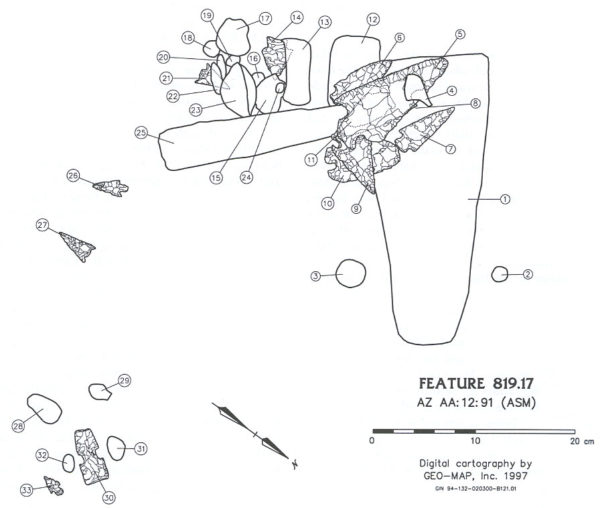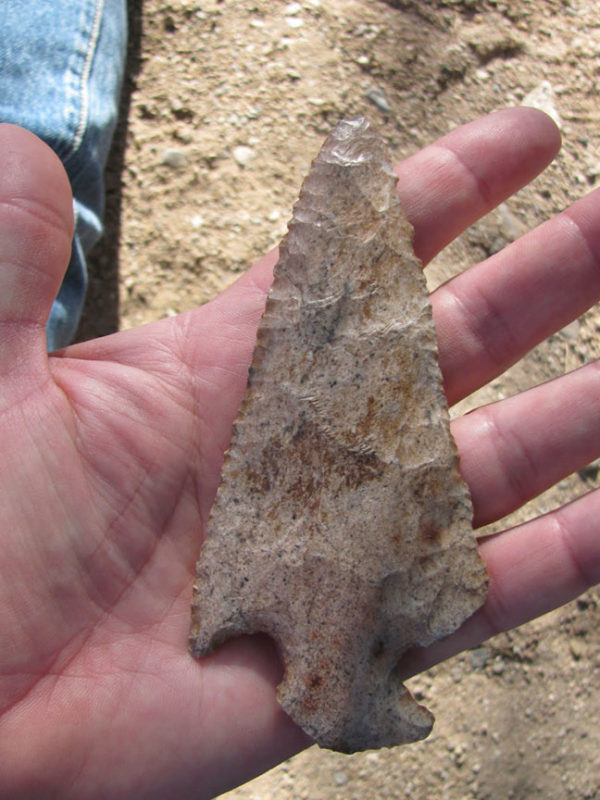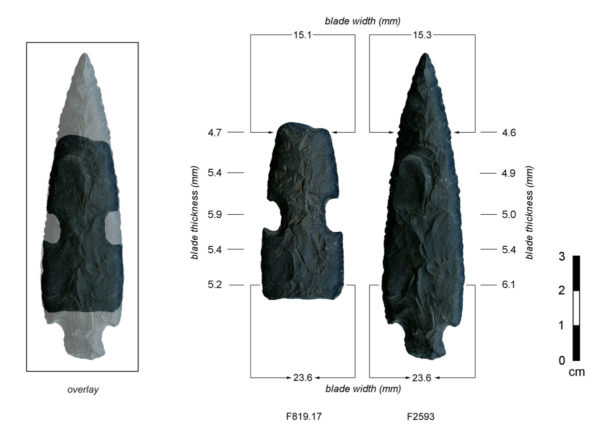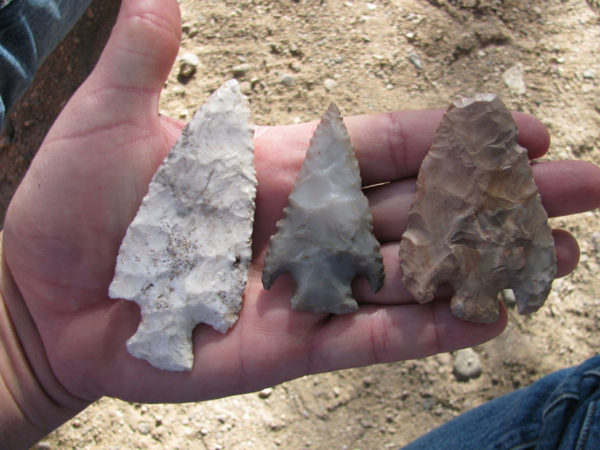
Early Agricultural Period Mystery: Revisiting the Artifact Array at Los Pozos
R J Sliva, Homer Thiel, and Jenny Adams discuss a unique collection of artifacts encountered at Los Pozos… and a matching piece found during a later excavation.
The Cienega phase of the Early Agricultural period in southern Arizona and northern Sonora lasted from about 800 BC to AD 50. A previous blog entry discussed the architecture of this time span, describing the many smallish, round pit structures people built for shelter and storage. Over the last 24 years Desert Archaeology has uncovered hundreds of these houses, mostly at sites located within the floodplain of the once-flowing Santa Cruz River.
Many of these houses were burned, and we have found the charred remnants lying inside the foundation pits. It is unclear how or why houses burned. A spark from the informal floor hearths may have accidentally ignited the grasses and reeds used to cover the walls and ceiling. Some houses may have been purposely burned to get rid of rodents and insects infesting them. Other houses may have been destroyed after an occupant died, something that was recorded among Historic period Native Americans living in the American Southwest.
Burned houses often contain artifacts that were either left behind as people fled the structure, or were placed inside or on top of the house prior to the structure purposefully being set on fire. The types of artifacts found vary from house to house. Among the items we have recovered so far are projectile points, stone bowls or trays, a turtle shell, lumps of red ochre, bone awls, shell beads, and even the skeleton of a small dog.
Among all of the excavated houses, the most unusual set of artifacts found to date was lying on the floor of Feature 819 at Los Pozos. This site is located in Tucson on the east side of the Santa Cruz River, north of modern-day Prince Road. A crescent of houses was uncovered by Desert Archaeology in 1995, with the eastern portion lying beneath the eastbound lane of I-10.
Feature 819 was located roughly in the center of the settlement, with a row of postholes around the perimeter of the house foundation pit, a few interior posts that may have helped hold up a sagging roof, and a central storage pit dug into the floor.

Map of pithouse Feature 819 at Los Pozos. The red square shows the location of the Feature 819.17 floor array.
Thirty-three items lay in a pile near the west wall of the house, a grouping of artifacts recorded as Feature 819.17. These include several projectile points, a fossilized horse tooth, a shaped mammoth or mastodon vertebra, a variety of ground stone pieces, stone flakes, and unworked but unusual rocks. Another three objects (a gastropod fossil, an oblong piece of siltstone, and a quartz crystal fragment) were found nearby and may have been part of the collection, but were perhaps moved away by rodent burrowing.

Schematic drawing of the floor array as it appeared after excavation; some items were dislodged from their original positions when they were initially uncovered.
The numbered items in the image are listed below, with notes from analyses performed by Desert Archaeology staff members Jenny Adams, Dave Gregory, and R. J. Sliva:
(1) Large piece of basalt, minimally shaped through grinding but with no usewear traces.
(2) Small stone ball (1.7 cm in diameter) formed by grinding or polishing a pebble; wear traces indicate this ball was wrapped with cordage or sinew, possibly to affix another object to the ball, or to suspend it as a decoration or weight.
(3) Larger stone ball (3.4 cm in diameter), similar to #2, but with no evidence of wrapping.
(4) Large (5.1 cm in length) fragmentary flake of fine-grained metamorphic stone.
(5) Very large (13 cm in length, 64.5 g) unidentified projectile point made of unidentified heat-treated chert.
(6) San Pedro point with reworked stem and fine serrations added to blade edges.
(7) San Pedro point.
(8) Large (9.8 cm in length, 30 g) unidentified point. The shape mimics that of much smaller Arizona Transition Zone points (designs originating along the Mogollon Rim in east-central Arizona) found at the site.

Item #8, with Arizona Transition Zone Pozos (middle two) and Geronimo (rightmost) points also found at Los Pozos for comparison.
(9) Unidentified point made from heat-treated cream and light gray banded chert, similar in design to contemporaneous points from the Arizona Transition Zone and southern Colorado Plateau, but rendered at a much larger size.
(10) Unidentified large (7.3 cm in length, 26 g) point made from unidentified heat-treated chert. The design evokes similar large Archaic points found in central Texas and the lower Pecos, but no definitive identification has been made as yet.
(11) San Pedro point.
(12) Mammoth or mastodon vertebra disk, not fossilized.
(13) Fossilized horse tooth.
(14) Elko point made of obsidian from the Cow Canyon source (west-central New Mexico).
(15) Geode fragment.
(16) Round pebble, naturally occurring shape (no evidence of grinding or polishing).
(17) Geode fragment.
(18) Small (2.4 cm in length) quartz flake.
(19) Geode fragment.
(20) Cylindrical stone, natural shape slightly enhanced through abrasion and then highly polished, possibly for use as an atlatl weight.
(21) Cienega point made from locally available chalcedony.
(22) Finely ground elongated prolate spheroid (football)-shaped piece of translucent red-orange chalcedony, shaped through abrasion against another stone and then highly polished with a soft surface, perhaps leather.
(23) Large medium-grained igneous flake (6 cm in length) with usewear on one edge.
(24) Round pebble, naturally occurring shape.
(25) Smaller piece of basalt similar to #1, minimally shaped through grinding but with no usewear traces.
(26) Cienega point made from locally available fine-grained rhyolite.
(27) Cienega point made from locally available fine-grained metasediment.
(28) Marekanite (small obsidian nodule) from the Sauceda Mountains of southwestern Arizona.
(29) Mineral concretion, possibly of hematite (iron ore).
(30) Projectile point blade modified with large notches placed in edges and broken ends ground smooth.
(31) Ovoid geometric stone, natural shape enhanced through abrasion and polishing, no evidence of wrapping.
(32) Stone ball (2.1 cm in diameter), formed by grinding or polishing similar to #2 and 3, also with evidence of having been wrapped.
(33) Cienega point made from locally available fine-grained igneous stone.

As big as the previous three points are, this one (item #5) dwarfs them. It remains the largest point yet encountered during a Desert Archaeology excavation. Although we cannot understand the cultural context and belief system that gave these items meaning, they certainly were valued by people who lived at Los Pozos more than two thousand years ago.
How do we know item #30, the point blade midsection, was modified rather than being originally designed this way? Being able to access curated collections at the Arizona State Museum (ASM) was crucial to answering this question. When Desert conducted subsequent investigations at Los Pozos in 2012, excavations within Feature 2593, a pithouse located in a different part of the site (more than 200 m to the west of Feature 819), recovered a complete point that looked oddly familiar to lithic analyst Sliva. After retrieving the array collection from ASM for a first-hand comparison, a close examination showed that the Feature 2593 point matches array item #30 in terms of shape, size, flaking technique, and type of stone used—probably as identically as possible with this kind of artifact. In addition, the dates obtained for the two features overlap, at 385 B.C.-A.D. 25 for Feature 819 and 200 B.C.-A.D. 50 for Feature 2593.

Comparison of the reworked point blade from the Feature 819.17 array at Los Pozos and a nearly identical point from Feature 2593 at the site, excavated 17 years later.
Many chains of events can be posited to explain how the two artifacts ended up where they did, including contemporaneous use of the two features, the person who made the complete point manufacturing and deliberately giving the companion piece to people who broke it and modified it and included it in the array, the people responsible for the array scavenging the broken-in-manufacture companion piece and modifying it into its final form, an unrelated person scavenging the companion (broken or not) and adding the notches/grinding and discarding it to be scavenged later by the array creators, or any number of other scenarios that would be equally plausible. All that is certain is that the two features are roughly contemporaneous, and the two pieces share enough morphological attributes to strongly suggest a common manufacturer and indelibly link the two pithouses in some fashion. Given this, the array becomes even more important for understanding not just ritual behaviors at the site, but the social relationships between people living in different parts of it.
Most of the array items, if found individually, would be considered unusual because of their exotic designs or their exotic materials. To find so many one-of-a-kind artifacts deliberately gathered together suggests this was a very special collection. It resembles sets of artifacts placed in medicine bundles used by Historic period Native American shamans and healers. Perhaps the man or woman who had collected and curated the items was a religious figure in the Los Pozos community.
The late David Gregory, project director for the Los Pozos excavations, thought the artifacts in the array had been purposely arranged to resemble images of broad-shouldered human figures seen in rock art from this time period elsewhere in the American Southwest. Whether this was the case remains unknown, but it seems clear that these artifacts had some sort of special, ceremonial purpose. Coming upon a matching projectile point—a piece that would have been impressive enough on its own—17 years after the array was originally discovered only adds to the questions and wonder surrounding the collection. We have returned to Los Pozos several times since the original 1995 excavations. As modern development continues near the site, we wonder what future investigations will encounter that will add to our understanding of this remarkable group of artifacts.
Resources
Dave Gregory’s report on the Los Pozos array, from Desert Archaeology Anthropological Papers No. 21.
The Early Agricultural Period Construction Boom, Homer Thiel’s blog post on architecture and construction techniques employed by people during the San Pedro and Cienega phases.







